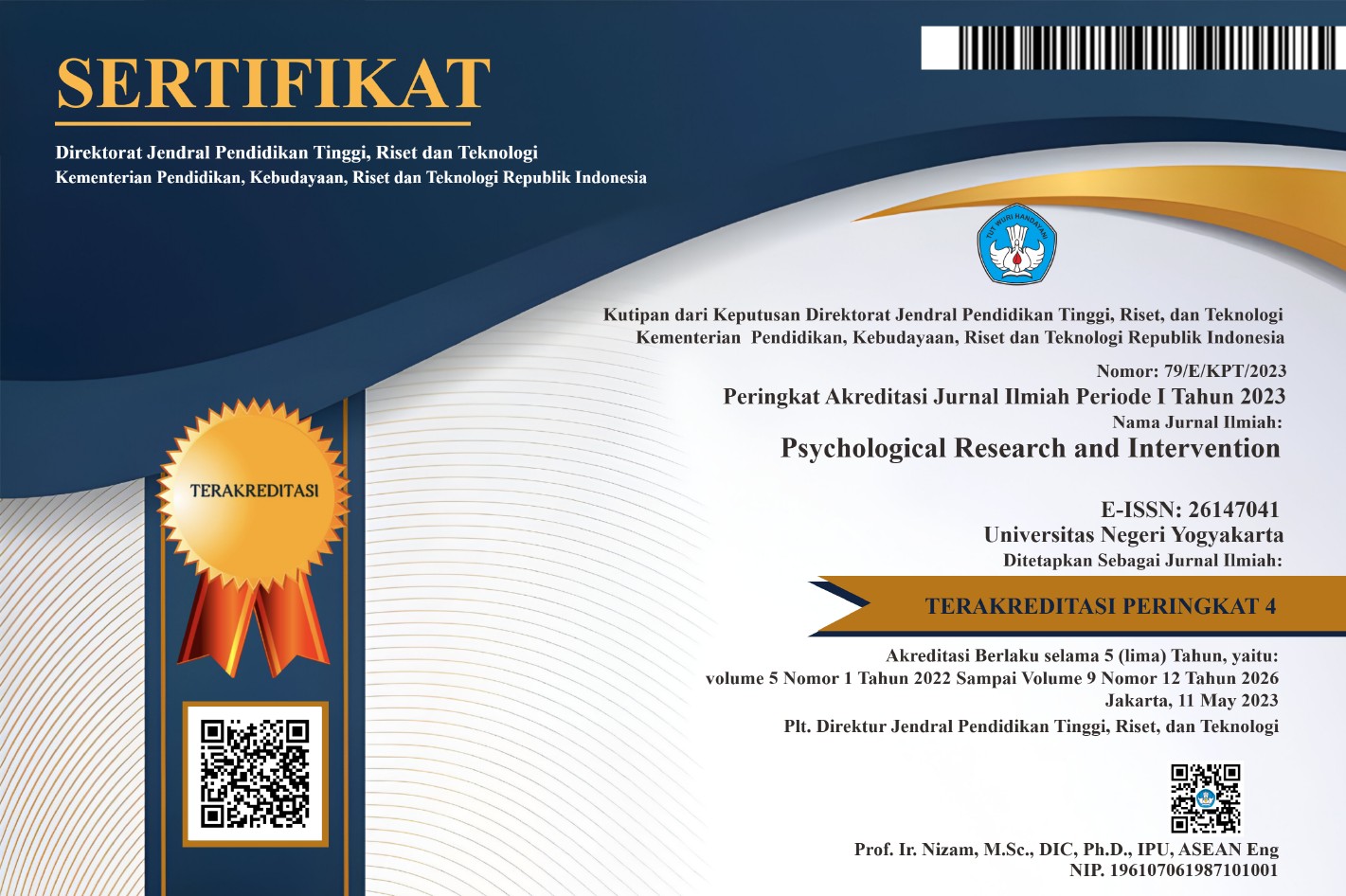Delinquency behavior from Adverse Childhood Experience
DOI:
https://doi.org/10.21831/pri.v6i1.54184Keywords:
adolescent, adverse childhood experience, delinquencyAbstract
Delinquent behavior includes breaking the rules to committing criminal acts. There are many factors behind delinquency behavior, both internally and externally. Externally, this behavior cannot be separated from events that occurred in childhood, especially events experienced in the family environment or as an Adverse Childhood Experience (ACE). Of the 6 delinquency groups in the Child Correctional Institution, this study intends to see what ACEs are experienced by juvenile delinquency perpetrators. The research subjects were taken as a whole as many as 72 teenagers. Data collection using the Adverse Childhood Experience scale. Data analysis using ANOVA. The results show that there is no difference in Adverse Childhood Experience in the 6 delinquency groups. From the average obtained, the group for drug crimes, sexual crimes, murder, theft, and child protection experienced 5 types of Adverse Childhood Experience, and the brawling group experienced 4 types of Adverse Childhood Experience. The types of Adverse Childhood experiences that are often experienced by juvenile delinquents are emotional neglect and physical neglect. 68% of teenagers who carry out delinquent behavior come from families whose parents work as laborer and traders
References
Arruda, M. A., & Arruda, R. (2014). Psychological adjustment in children with episodic migraine: A population-based study. Psychology and Neuroscience, 7(1), 33–41. https://doi.org/10.3922/j.psns.2014.1.06
Baglivio, M. T., Wolff, K. T., Epps, N., & Nelson, R. (2017). Predicting Adverse Childhood Experiences: The Importance of Neighborhood Context in Youth Trauma Among Delinquent Youth. Crime and Delinquency, 63(2), 166–188. https://doi.org/10.1177/0011128715570628
Cicchetti, D. (2010). Resilience under conditions of extreme stress: a multilevel perspective. World Psychiatry, 15–18.
Collingwood, S., Knox, A., Fowler, H., Harding, S., Irwin, S., & Quinney, S. (2018). The Little Book of Adverse Childhood Experiences.
Delisi, M., Alcala, J., Kusow, A., Hochstetler, A., Heirigs, M. H., Caudill, J. W., Trulson, C. R., & Baglivio, M. T. (n.d.). Adverse Childhood Experiences , Commitment Offense , and Race / Ethnicity : Are the Effects Crime- ,. https://doi.org/10.3390/ijerph14030331
Di Lemma, L. C. G., Davies, A. R., Ford, K., Hughes, K., Homolova, L., Gray, B., & Richardson, G. (2019). Responding to adverse childhood experiences: an evidence review of interventions to prevent and address adversity across the life course (Issue May).
Felitti, V. J., Anda, R. F., Nordenberg, D., Williamson, D. F., Spitz, A. M., Edwards, V., Koss, M. P., & Marks, J. S. (2019). Relationship of Childhood Abuse and Household Dysfunction to Many of the Leading Causes of Death in Adults: The Adverse Childhood Experiences (ACE)Study. American Journal of Preventive Medicine, 56(6), 774–786. https://doi.org/10.1016/j.amepre.2019.04.001
Fox, B. H., Perez, N., Cass, E., Baglivio, M. T., & Epps, N. (2015). Trauma changes everything: examining the relationship between adverse childhood experiences and serious, violent and chronic juvenile offenders. Child Abuse & Neglect, 46, 163–173. https://doi.org/10.1016/j.chiabu.2015.01.011
Friedman, J. M. (2018). A Grounded Theory Investigation of Adaptations to Adverse Childhood Experiences. ProQuest Dissertations and Theses, 32, 247. http://ezproxy.lib.ryerson.ca/login?url=https://search.proquest.com/docview/2171051318?accountid=13631%0Ahttp://sfx.scholarsportal.info/ryerson??url_ver=Z39.88-2004&rft_val_fmt=info:ofi/fmt:kev:mtx:dissertation&genre=dissertations+%26+theses&sid=ProQ:ProQ
Joseph F. Hair, William C. Black, Barry J. Babin, R. E. A.-M. D. A. (7th E.-P. H. (2009). (2010). Overview of Multivariate Methods.
Kartono, K. (n.d.). Kartini Kartono, Kenakalan remaja (Jakarta, RajaGrafindo Persada 2017), hlm 6. 19–56.
Kimple, K. S., & Kansagra, S. M. (2018). Responding to Adverse Childhood Experiences: It Takes a Village. North Carolina Medical Journal, 79(2), 95–98. https://doi.org/10.18043/ncm.79.2.95
Mark Corcoran, M. M. 2018. (n.d.). Examining the role of attachment in the relationship between childhood adversity, psychological distress and subjective well-being.
Matsuura, N., Hashimoto, T., & Toichi, M. (2009). Correlations among self-esteem, aggression, adverse childhood experiences and depression in inmates of a female juvenile correctional facility in Japan: Regular article. Psychiatry and Clinical Neurosciences, 63(4), 478–485. https://doi.org/10.1111/j.1440-1819.2009.01996.x
Sidebotham, P., & Golding, J. (2001). Child maltreatment in the "Children of the nineties": A longitudinal study of parental risk factors. Child Abuse & Neglect, 25(9), 1177–1200. https://doi.org/https://doi.org/10.1016/S0145-2134(01)00261-7
Stith, S. M., Liu, T., Davies, L. C., Boykin, E. L., Alder, M. C., Harris, J. M., Som, A., McPherson, M., & Dees, J. E. M. E. G. (2009). Risk factors in child maltreatment: A meta-analytic review of the literature. Aggression and Violent Behavior, 14(1), 13–29. https://doi.org/https://doi.org/10.1016/j.avb.2006.03.006












